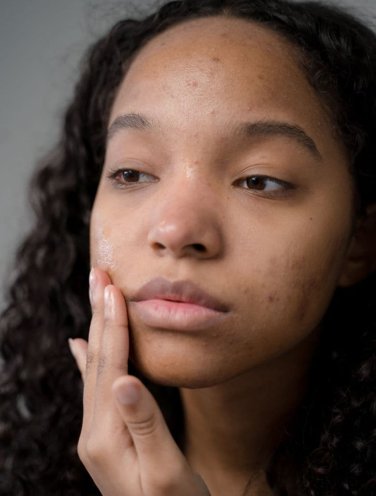5 Common Skin Conditions And How To Treat Them

There’s no such thing as perfect skin. But some skin conditions hit us harder: flaky and itchy skin is unbearable; severe acne brings so much discomfort; hyperpigmentation – well, don’t even get us started.
These common skin conditions cause distress for most of us, with experts saying skin conditions rank fourth leading cause of nonfatal disease burden.
It affects us in many ways, both physically and mentally, emotionally and financially.
We explain the seven most common skin conditions experts see and proven ways to treat or tame them with suitable
1. Acne

What is Acne?
Acne is a common skin condition that affects 95% of people aged 11 to 30. It can take several forms like non-inflammatory pesky blackheads and whiteheads and the mild tiny red dots known as pimples.
The causes are varied and brought on by a series of factors from hormonal imbalance and diet to lack of sleep, improper skincare routine and stress.
How to treat it?
“Treatment depends on the acne severity,” says Dr Gabriela Petrof, MBBS, PhD, NHS Consultant Dermatologist.
For zit-zap emergencies, we love
For serum, we recommend
2. Eczema
What is Eczma?
In the UK alone, eczema affects up to 20% of children and 10% of adults. It’s an inflammatory skin condition that causes dry skin, itchy skin, rashes, scaly patches, blisters and skin infections. Itchy skin is a common symptom of eczema.
How to treat it?
Dr Petrof advises: “Applying frequent topical emollients and using soap-free products are the mainstay of treatment. Identification and avoidance of triggers are also important.”
People with eczema could benefit from the richness of Shea butter. Shea butter, an emollient, is proven to have efficient anti-inflammatory properties which help calm down any dryness, redness, or flakiness of the skin.
We are a fan of the emollient-rich
For shower gel, you should look for a skincare formula that is gentle enough for the most sensitive skin. Our
For face, a plethora of gentle cleansers would work, too. Look for ones that contain shea butter or oat extract. We recommend a cleanser loaded with AHAs like
3. Rosacea
What is Rosacea?
Constant rosy cheeks. People who have rosacea can cause persistent blushing or flushing in the face.
A substantial proportion of the patients I see have rosacea. This is a chronic condition with a significant psychological impact.
Rosacea is commonly characterised by background inflammation (affecting the forehead, nose, cheeks, chin); some patients also experience spots/bumps in the centre portion of the face,” Dr Alia Ahmed, NHS Consultant Dermatologist explains.
How to treat it?
Dr Ahmed says: “Management of rosacea is complex, it is usually a combination of medical, skincare, lifestyle and psychological management.”
As for the skincare routine, Dr Ahmed says, “It typically includes
Our
We also recommend Clarins
Need help? Book an
4. Dry heels
What are Dry Heels?
Dry heels are a widespread skin condition that affects us all. 90% of UK women have foot problems, and the College of Podiatry reveals that 45% of women suffer from painful cracked heels. No wonder Dr Gendler sees this as so common to her patients.
“While this is a problem we often see in the winter, it occurs all year round. It is important to remember that the skin on the feet takes quite a beating, and it thickens to protect itself and your underlying bone structure.
Constantly buffing and scrubbing the soles is not the answer, though many people do this! The vigorous paring of the soles leads to worse thickening because the skin constantly believes it needs to.” she explains.
How to treat it?
New York-based dermatologist Dr Gendler recommends foot creams once or twice a day that contains lactic acid or urea in an emollient base. You will need to go through a week or so when your heels seem even more cracked and dry, but once the habit of using creams there sets in, you will be so happy.
5. Hyperpigmentation
What is Hyperpigmentation?
“Hyperpigmentation is when certain areas of your skin are darker than the rest. There are multiple causes known for triggering hyperpigmentation: sun exposure, irritation from skincare products, melasma, the ageing process, inflammation on the skin, and allergic drug reaction to other very rare medical conditions,” says Dr Anastasia Therianou MD, PhD, London-based NHS consultant dermatologist.
Age spots, also called sunspots, are the most common type of hyperpigmentation. Age and sun are both common reasons someone may develop this condition.
How to treat it?
To prevent hyperpigmentation from worsening or, better yet, from happening, make sure to use
Natural retinol is also effective in treating hyperpigmentation. We recommend a plant alternative 40% better than the Vitamin A derivative, Organic Harungana. It is found in
For hyperpigmentation on body, especially neck area,
